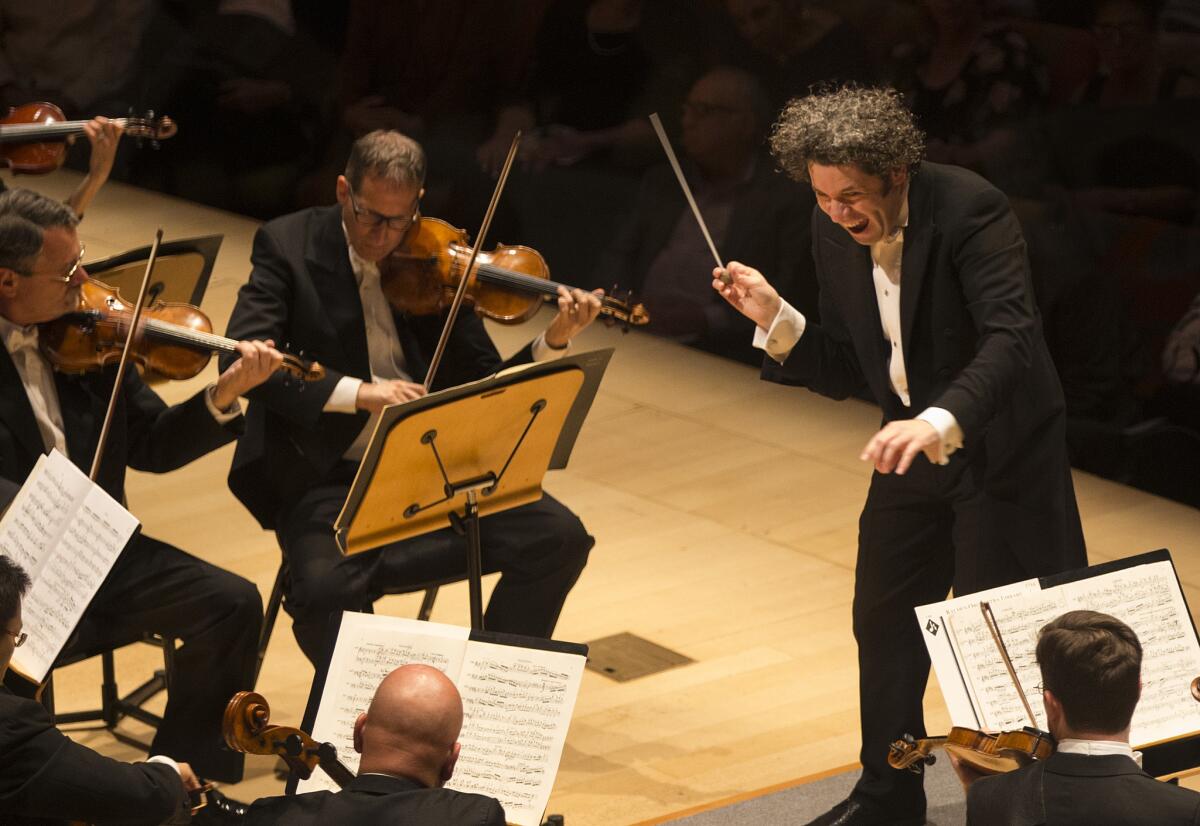Review: Mahler lives! Dudamel gives his most impressive performance yet with L.A. Phil

A Zen-like cautionary notice on the trains of the Tokyo Metro, I noticed on a recent trip, could be interpreted as a koan on the meaning of life: “Doors close soon after the melody ends.”
This might also be the motto of Mahler’s last-completed symphony, his Ninth, often construed to be a death-obsessed composer’s ultimate premonitions. The symphony ends with the closing of doors after the final melody fades. Only this time, the train has left the station without him.
Thursday night, in what felt like the most impressive performance Gustavo Dudamel has yet given with the Los Angeles Philharmonic, the doors remained opened at Walt Disney Concert Hall at the end of Mahler’s Ninth.
At the symphony’s end, melody decays into a couple of hesitant individual notes in the violas. The L.A. Phil strings reached the shocking edge of audibility, following Mahler’s final instruction: ersterbend (dying).
Dudamel remained on the podium for a full minute in still meditation. Yet the melody had been so immediately in the air that it seemed to linger. For Dudamel, the Ninth is not a Mahlerian book of the dead but an effusive ode to life.
The symphony has meant much to Dudamel and to the L.A. Phil. Too little attention has been paid to the Mahler tradition in Los Angeles. Mahler’s widow, Alma, and his daughter, Anna, were royalty among the German and Austrian émigré communities in the Los Angeles of the last century.
The L.A. Phil music director at the time was Otto Klemperer, who had been an assistant to Mahler, as had Bruno Walter, who also moved to Los Angeles. The L.A. Phil program lists the orchestra’s first performance of Mahler’s Ninth as 1969, when John Barbirolli led a death-stalked performance eight months before his own death. But Walter’s less demonstrative 1961 recording by the Columbia Symphony (the Columbia Records house band) was made in Hollywood with essentially L.A. Phil players. It was incidentally another otherworldly guest performance by Carlo Maria Giulini (so death-stalked that false rumors began circulating about the Italian conductor having fatal cancer) that resulted in his becoming music director in 1978.
Many of the finest recordings of the Ninth are by conductors who were L.A. Phil music directors (Klemperer, Guilini and Esa-Pekka Salonen) or principal guest conductors (Michael Tilson Thomas and Simon Rattle), but none is with the L.A. Phil. That honor finally went to Dudamel in 2012. A year earlier he had taken the symphony on his first European tour with the orchestra, a bold move for a conductor under 30 and in just his second season as music director.
A music critic’s responsibility no doubt should be to listen again to Dudamel’s recording and compare it with the latest performance. He is about to take the symphony on another tour, this time of the West Coast, and this is an obvious opportunity for charting the growth of a young maestro. But maybe that is too obvious. Since Dudamel treats the Ninth as a symphony of life, not death, I chose to experience this as music-making in the moment, not as a dialogue with history and/or death.
But nothing prepared me for the sheer effusiveness of this performance. If the symphony ends with the decomposition of melody it begins with the flowing of creation. Gorgeous phrases begin, first violins finishing what the second start, horns picking up strands and handing them off to woodwinds, which go someplace else. A harp plucks, and it sounds like an angel is at the reins.
Dudamel made this an absolutely joyous symphony of swells, implying climaxes but never fully reaching them so that we could have the continual expectation of more.
The second movement, Mahler’s take on the Austrian folk dance known as the Ländler, was not a nostalgic looking back but once more in the moment, a dance of rhythms actually made for dancing. The Rondo-Burlesque got crazy but, sorry Halloweeners, not macabre Mahler.
And then there is that Adagio, easily the greatest elegy in all symphonic literature. Dudamel sculpted it for beauty. Although he maintained a strong line throughout, he stopped time and again to smell the roses, lingering in exquisite sound fields, the kind you find only in modern music. He did give here (and throughout the symphony) unusual prominence to alto instruments, such as viola and horn — with, respectively, Dale Hikawa Silverman and Andrew Bain superbly mellow. But this never sounded like an elegy, rather a vision of new, maybe better, worlds.
The L.A. Phil wasn’t perfect. There was a missed entrance or two, a broken note once in a great while. But perfection would have ruined it. The orchestra was, instead, great — robust, alive to everything, chance-taking, bursting with color, taking expression to the outer limits, living for Mahler.
Try to hear this if you possibly can.
----------
Gustavo Dudamel conducts the L.A. Phil in Mahler’s Symphony No. 9
In L.A.: 8 p.m. Saturday and 2 p.m. Sunday at Walt Disney Concert Hall, 111 S. Grand Ave. $65-$201. (323) 850-2000 or www.laphil.com
In Costa Mesa: 8 p.m. Oct. 29 at Renee and Henry Segerstrom Concert Hall, Costa Mesa. $50-$350. (949) 553-2422 or www.philharmonicsociety.org
More to Read
The biggest entertainment stories
Get our big stories about Hollywood, film, television, music, arts, culture and more right in your inbox as soon as they publish.
You may occasionally receive promotional content from the Los Angeles Times.







